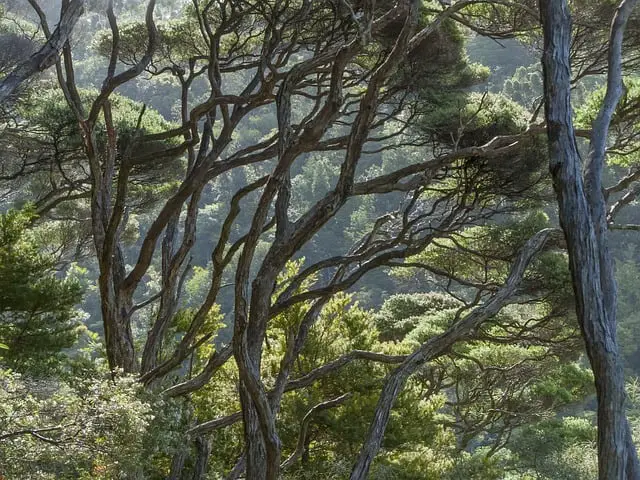New Zealand, known for its breathtaking landscapes and rich Maori culture, is also home to a remarkable tree species—the Manuka tree. While Manuka honey is perhaps the most famous export associated with this tree, there’s another treasure to discover: Manuka wood.
For travelers and tourists visiting this enchanting land, Manuka wood products make for meaningful and authentic souvenirs that capture the essence of New Zealand especially given that Manuka wood products are typically not exported to any degree.
In this post, we’ll explore the beauty of Manuka wood, its significance, and the variety of souvenirs you can bring back from your New Zealand adventure.
The Charm of Manuka Wood
Manuka wood, sourced from the native New Zealand Manuka tree (Leptospermum scoparium), is prized for its unique qualities. The wood exhibits a beautiful grain pattern with intricate swirls and variations in color, ranging from light browns to reddish hues. Its density and durability make it ideal for various woodworking projects, while its natural charm adds a touch of New Zealand’s wilderness to any piece.
Manuka (Leptospermum scoparium) is native to New Zealand and can be found growing throughout the country, particularly in the North Island and the northern regions of the South Island. It is a common and widespread plant in New Zealand’s natural landscapes.
Manuka trees thrive in a variety of environments, including coastal areas, lowland forests, scrublands, and higher elevation regions. Their ability to adapt to different conditions has contributed to their widespread distribution.
Why Choose Manuka Wood Souvenirs?
When selecting souvenirs from your travels, you want something that not only reminds you of the place but also carries a piece of its culture and natural beauty. Manuka wood souvenirs offer several compelling reasons to consider:
- Authenticity: Manuka wood is native to New Zealand, and by choosing Manuka wood souvenirs, you’re opting for something deeply rooted in the country’s natural heritage.
- Unique Patterns: No two pieces of Manuka wood are alike. The distinctive grain patterns ensure that your souvenir is one-of-a-kind, just like your travel experience.
- Durability: Manuka wood is known for its durability and resistance to wear and tear. Your souvenir will last a lifetime and beyond, making it a true heirloom.
- Versatility: From kitchen utensils and bowls to jewelry and decorative items, Manuka wood is used to craft a wide range of products, catering to different tastes and preferences.
Common Manuka Wood Souvenirs and Their Uses
| Souvenir | Common Uses |
|---|---|
| Kitchen Utensils: | Cutting boards, serving platters, spoons, and spatulas. |
| Bowls and Plates: | Salad bowls, decorative plates, and serving dishes. |
| Jewelry: | Necklaces, earrings, and bracelets crafted from Manuka wood. |
| Decorative Items: | Vases, sculptures, and home décor pieces. |
| Gifts and Keepsakes: | Souvenir figurines, keychains, and ornaments. |
| Furniture: | Small furniture items like side tables and stools. |
| Artistic Creations: | Hand-carved sculptures and Maori-inspired artwork. |
These souvenirs not only serve as functional and beautiful additions to your home but also carry the spirit of New Zealand with them. They make for thoughtful gifts and tokens of your journey, whether it’s a wooden spoon that becomes a beloved kitchen companion or a hand-carved sculpture that sparks conversations and memories.
When you choose Manuka wood souvenirs, you’re not just acquiring objects; you’re taking home a piece of New Zealand’s natural wonder, culture, and craftsmanship. Each piece tells a story of this beautiful land and the skillful hands that shaped it.
So, when you visit New Zealand, don’t forget to explore the world of Manuka wood souvenirs, where the artistry of nature meets the artistry of humankind.
Manuka Wood Summarized
Here’s a table that provides information on the characteristics of Manuka trees and Manuka wood:
| Characteristic | Manuka Trees and Wood |
|---|---|
| Scientific Name | Leptospermum scoparium |
| Common Names | Manuka, New Zealand Tea Tree |
| Family | Myrtaceae |
| Origin | Native to New Zealand |
| Tree Height | Typically 3 to 4 meters (10 to 13 feet) |
| Wood Color | Light to medium brown, reddish-brown |
| Wood Grain | Fine, even grain with occasional swirls |
| Density | Moderate to high-density wood |
| Durability | Moderately durable, resistant to decay |
| Workability | Relatively easy to work with hand tools |
| Uses | – Furniture, including small items and tables – Decorative items and art – Jewelry and small accessories – Kitchen utensils and cutting boards – Musical instruments (rarely) – Food smoking |
| Resistance | – Resistant to decay and insect infestations – Tolerant of harsh environmental conditions |
| Finishing | Accepts stains, finishes, and polishing well |
| Sustainability | – Generally considered sustainable when harvested responsibly – Conservation efforts are in place to protect native Manuka populations |
| Availability | – Availability may vary based on conservation regulations and responsible harvesting practices – Limited availability for export due to conservation concerns which is why buying it as a souvenir when you are there makes sense. |
Manuka trees and wood are known for their unique qualities and suitability for various woodworking and decorative applications. It’s important to note that conservation efforts are in place to protect native Manuka populations, so responsible sourcing and harvesting practices are encouraged to ensure the long-term sustainability of this valuable resource.

